Archive for January, 2013
» posted on Wednesday, January 23rd, 2013 by Linda Lou Burton
Story Telling Time
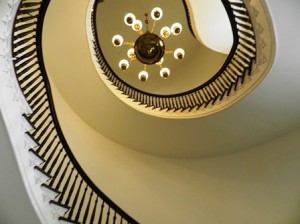 Linda Burton posting from Montgomery, Alabama – The prettiest thing in the Alabama state capitol is the spiral staircase. At least, that’s my opinion; I had to stop the minute I entered the door and look up, in wonder. It is stunning, and mysterious. And then I noticed there are two; a pair of cantilevered spiral staircases graces the entrance hall, curving upwards for three stories in simple elegance, one of the building’s finest architectural features. This capitol was in use by 1851; the story goes the staircases were built by Horace King, a slave who was freed in 1846. Horace was
Linda Burton posting from Montgomery, Alabama – The prettiest thing in the Alabama state capitol is the spiral staircase. At least, that’s my opinion; I had to stop the minute I entered the door and look up, in wonder. It is stunning, and mysterious. And then I noticed there are two; a pair of cantilevered spiral staircases graces the entrance hall, curving upwards for three stories in simple elegance, one of the building’s finest architectural features. This capitol was in use by 1851; the story goes the staircases were built by Horace King, a slave who was freed in 1846. Horace was  known in Alabama, and surrounding states, for his talent as a bridge builder; because of this the Alabama legislature passed a special law exempting him from the state’s manumission laws, which required freed slaves to leave the state within a year of gaining their freedom. So Horace stayed, and after the Civil War he got into politics; serving two terms in the Alabama House of Representatives, in the building he helped design and build. The Alabama capitol is full of stories, as is true of any building of this many years. Two
known in Alabama, and surrounding states, for his talent as a bridge builder; because of this the Alabama legislature passed a special law exempting him from the state’s manumission laws, which required freed slaves to leave the state within a year of gaining their freedom. So Horace stayed, and after the Civil War he got into politics; serving two terms in the Alabama House of Representatives, in the building he helped design and build. The Alabama capitol is full of stories, as is true of any building of this many years. Two 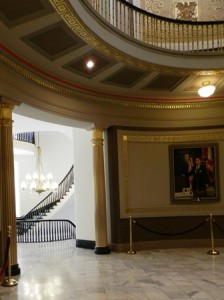 of the most famous are its use during the Civil War, as it briefly served as capitol of the Confederate States before that seat of government moved to Richmond; and its use as a destination point during the Civil Rights movement in the 1960’s. Today I was looking for stories; I’d heard about the murals so I headed for the second floor; I knew that much of the history of Alabama was displayed beneath the dome. Another story behind that; artist Roderick MacKenzie lived in an Alabama orphanage for a time. A freed slave and an orphan, two men whose creativity became part of the Alabama story. » read more
of the most famous are its use during the Civil War, as it briefly served as capitol of the Confederate States before that seat of government moved to Richmond; and its use as a destination point during the Civil Rights movement in the 1960’s. Today I was looking for stories; I’d heard about the murals so I headed for the second floor; I knew that much of the history of Alabama was displayed beneath the dome. Another story behind that; artist Roderick MacKenzie lived in an Alabama orphanage for a time. A freed slave and an orphan, two men whose creativity became part of the Alabama story. » read more
» posted on Monday, January 21st, 2013 by Linda Lou Burton
Hey, Good Lookin’
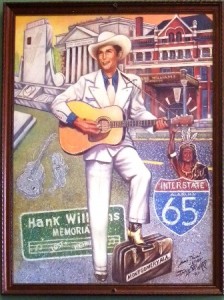 Linda Burton posting from Montgomery, Alabama – When Hank Williams moved to Montgomery in 1937 at the age of 14, Chris Katechis’ restaurant had already been open for twenty years. I’m sitting in Chris’ Place today, eating two of his famous hotdogs, beside a wall decorated in musical notes. I came in because I’d read that Hank Williams used to sit in Chris’ and write songs, and sure enough, I spotted a large poster of Hank as I came in the front door. “Do the musical notes have anything to do with Hank’s songwriting?” I asked my server, as she brought homemade onion rings stacked up cute like a tree. She went away to find out. The lady in the booth across the aisle had advised me on my order. “I worked here myself, back in the 60’s,” she told me, admitting she had no idea what was in the famous secret sauce Chris ladled over his hotdogs. “That’s why it’s called a secret,” she grinned. My server came back to tell me the musical notes on the wall were a part of the original décor, “just because Mr Chris liked
Linda Burton posting from Montgomery, Alabama – When Hank Williams moved to Montgomery in 1937 at the age of 14, Chris Katechis’ restaurant had already been open for twenty years. I’m sitting in Chris’ Place today, eating two of his famous hotdogs, beside a wall decorated in musical notes. I came in because I’d read that Hank Williams used to sit in Chris’ and write songs, and sure enough, I spotted a large poster of Hank as I came in the front door. “Do the musical notes have anything to do with Hank’s songwriting?” I asked my server, as she brought homemade onion rings stacked up cute like a tree. She went away to find out. The lady in the booth across the aisle had advised me on my order. “I worked here myself, back in the 60’s,” she told me, admitting she had no idea what was in the famous secret sauce Chris ladled over his hotdogs. “That’s why it’s called a secret,” she grinned. My server came back to tell me the musical notes on the wall were a part of the original décor, “just because Mr Chris liked 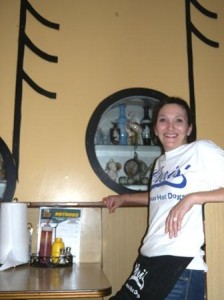 music,” she said. Enter Gus, a third generation Katechis, who sat down in my booth and told me a little more about the restaurant, and Hank. “There was a jukebox in here, and Hank always sat in the back booth. Sometimes he’d write, and always he drank. When he’d drunk a little too much, he’d start womanizing. And when he got a little too boisterous, my grandfather would help him out the door. But Hank was a good guy.” “What songs did he write in here?” I asked, but no one had the answer to that. “Maybe Hey, Good Lookin’, whatcha got cookin’?” Gus gave me his card and invited me to come back as often as I could. » read more
music,” she said. Enter Gus, a third generation Katechis, who sat down in my booth and told me a little more about the restaurant, and Hank. “There was a jukebox in here, and Hank always sat in the back booth. Sometimes he’d write, and always he drank. When he’d drunk a little too much, he’d start womanizing. And when he got a little too boisterous, my grandfather would help him out the door. But Hank was a good guy.” “What songs did he write in here?” I asked, but no one had the answer to that. “Maybe Hey, Good Lookin’, whatcha got cookin’?” Gus gave me his card and invited me to come back as often as I could. » read more
» posted on Saturday, January 19th, 2013 by Linda Lou Burton
Standing On The Promises
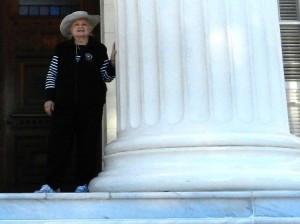 Linda Burton posting from Montgomery, Alabama – I stood on the star today. That’s the star the Sophie Bibb Chapter of the Daughters of the Confederacy placed on the spot where Jefferson Davis (1808-1889) stood when he was inaugurated President of the Confederate States of America on February 18, 1861. With one hand on the majestic white columns of the Alabama state capitol, I gazed down the marble steps it took me a while to climb; I looked further down the slope that’s still affectionately known as Goat Hill, because it once was pastureland for Andrew Dexter’s goats; I scanned the blocks on the street we know today as Dexter Avenue. Stand on that spot and you are standing in the pages of a history book. A block away the steeple rises above the modest red-brick church where Martin Luther King Jr (1929-1968) was pastor from 1954 to 1960. It’s now known as the
Linda Burton posting from Montgomery, Alabama – I stood on the star today. That’s the star the Sophie Bibb Chapter of the Daughters of the Confederacy placed on the spot where Jefferson Davis (1808-1889) stood when he was inaugurated President of the Confederate States of America on February 18, 1861. With one hand on the majestic white columns of the Alabama state capitol, I gazed down the marble steps it took me a while to climb; I looked further down the slope that’s still affectionately known as Goat Hill, because it once was pastureland for Andrew Dexter’s goats; I scanned the blocks on the street we know today as Dexter Avenue. Stand on that spot and you are standing in the pages of a history book. A block away the steeple rises above the modest red-brick church where Martin Luther King Jr (1929-1968) was pastor from 1954 to 1960. It’s now known as the 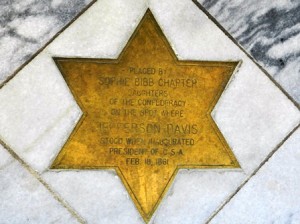 Dexter Avenue King Memorial Baptist Church; the Montgomery bus boycott was organized here December 2, 1955. A few blocks more down Dexter Avenue is the Court Square Fountain, where Rosa Parks (1913-2005) boarded a city bus and refused to give up her seat to a white man, an act of civil disobedience at the time; a history-making choice. I’m in a history book all right, but civil war and civil rights are not the whole of it. There’s more. » read more
Dexter Avenue King Memorial Baptist Church; the Montgomery bus boycott was organized here December 2, 1955. A few blocks more down Dexter Avenue is the Court Square Fountain, where Rosa Parks (1913-2005) boarded a city bus and refused to give up her seat to a white man, an act of civil disobedience at the time; a history-making choice. I’m in a history book all right, but civil war and civil rights are not the whole of it. There’s more. » read more
» posted on Thursday, January 17th, 2013 by Linda Lou Burton
To Leave A Legacy
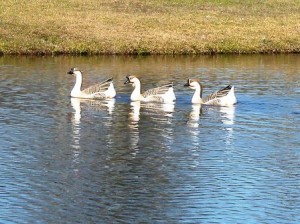 Linda Burton posting from Montgomery, Alabama – The Spanish moss hanging in the trees is a southern give-away. Otherwise, you’d think you were wandering the fields near an English village, complete with geese on the pond and cobblestone paths and, of course, a Shakespearian theater. But you’re really in the Wynton M Blount Cultural Park in Montgomery, Alabama, location of the Alabama Shakespeare Festival (ASF), the sixth largest Shakespeare festival in the world. Bringing in more than 300,000 visitors from all 50 states and over 60 countries every year, the performing arts complex in the park has been a part of the Montgomery scene since 1985, thanks to the generosity of a certain Mr and Mrs Blount. What a gift! The park itself is 250 acres of landscaped paths and ponds, trees and open space; there’s a wooden bridge with
Linda Burton posting from Montgomery, Alabama – The Spanish moss hanging in the trees is a southern give-away. Otherwise, you’d think you were wandering the fields near an English village, complete with geese on the pond and cobblestone paths and, of course, a Shakespearian theater. But you’re really in the Wynton M Blount Cultural Park in Montgomery, Alabama, location of the Alabama Shakespeare Festival (ASF), the sixth largest Shakespeare festival in the world. Bringing in more than 300,000 visitors from all 50 states and over 60 countries every year, the performing arts complex in the park has been a part of the Montgomery scene since 1985, thanks to the generosity of a certain Mr and Mrs Blount. What a gift! The park itself is 250 acres of landscaped paths and ponds, trees and open space; there’s a wooden bridge with 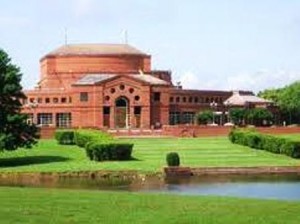 a stone structure atop, perfect for a sit as you watch the ducks swimming below. Montgomery’s Museum of Fine Arts is on one side of the park; meandering roads take you to the Shakespearian edge on the other side. Thatched-roof restrooms? An English garden? You’ve reached the Carolyn Blount Theater, which houses the 750-seat Festival Stage; there is a 225-seat Octagon Theater too. You’ll find Shakespeare here, and more. » read more
a stone structure atop, perfect for a sit as you watch the ducks swimming below. Montgomery’s Museum of Fine Arts is on one side of the park; meandering roads take you to the Shakespearian edge on the other side. Thatched-roof restrooms? An English garden? You’ve reached the Carolyn Blount Theater, which houses the 750-seat Festival Stage; there is a 225-seat Octagon Theater too. You’ll find Shakespeare here, and more. » read more
» posted on Tuesday, January 15th, 2013 by Linda Lou Burton
In The Land Of Cotton
 Linda Burton posting from Montgomery, Alabama – It started as I was leaving Florida. Farmland, I mean. Just north of Gainesville I spotted cattle grazing; their green pastures half hidden behind oak trees hanging thick with moss; the soft morning fog creating pastoral scenes worthy of an art collector’s wall. You might think of Florida as the citrus state, but what I saw coming north on I-75 was cattle, and billboard ads for western wear. I crossed the Suwanee River; notes painted on its sign set the tune off in my head. Nothing touristy here, just homefolks, working their land. I’m headed for Alabama today, and Montgomery, but there’s a stop I want to make
Linda Burton posting from Montgomery, Alabama – It started as I was leaving Florida. Farmland, I mean. Just north of Gainesville I spotted cattle grazing; their green pastures half hidden behind oak trees hanging thick with moss; the soft morning fog creating pastoral scenes worthy of an art collector’s wall. You might think of Florida as the citrus state, but what I saw coming north on I-75 was cattle, and billboard ads for western wear. I crossed the Suwanee River; notes painted on its sign set the tune off in my head. Nothing touristy here, just homefolks, working their land. I’m headed for Alabama today, and Montgomery, but there’s a stop I want to make  along the way. It has to do with farming, and with change. West on I-10, traffic thins and pine trees thicken; then I turn north again. Off the freeway driving slows; there’s farmland everywhere; I find myself on Cotton Street. And yes, a cotton field is to my left. The stop I want to make? The Boll Weevil Monument in Enterprise, Alabama, the only monument to an agricultural pest anywhere in the world. » read more
along the way. It has to do with farming, and with change. West on I-10, traffic thins and pine trees thicken; then I turn north again. Off the freeway driving slows; there’s farmland everywhere; I find myself on Cotton Street. And yes, a cotton field is to my left. The stop I want to make? The Boll Weevil Monument in Enterprise, Alabama, the only monument to an agricultural pest anywhere in the world. » read more
» posted on Monday, January 7th, 2013 by Linda Lou Burton
Still In Tallahassee
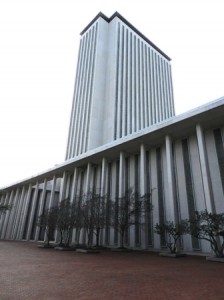 Linda Burton posting from Tallahassee, Florida – “This plaque is dedicated to Senator Lee Wisenborn whose valiant effort to move the Capitol to Orlando was the prime motivation for the construction of this building.” A touch of humor, and a telling dedication. The nontraditional Florida capitol is the newest in the country, a modern 22-story tower that rises 307 feet from the public entrance on the Plaza Level to the Observation Deck. It is the fourth building to serve as Florida’s capitol; officially dedicated March 31, 1978. Immediately after its opening, restoration began on the Old Capitol, which sits in front of the new “like a jewel,” with white columns, picturesque grounds, and (although they were down the day I was there) red-striped awnings over the windows. The Old Capitol is a museum today, refurbished to its 1902 appearance, but it was almost bulldozed during the controversy over how to gain space, and where to do it. Tallahassee is not centrally located in
Linda Burton posting from Tallahassee, Florida – “This plaque is dedicated to Senator Lee Wisenborn whose valiant effort to move the Capitol to Orlando was the prime motivation for the construction of this building.” A touch of humor, and a telling dedication. The nontraditional Florida capitol is the newest in the country, a modern 22-story tower that rises 307 feet from the public entrance on the Plaza Level to the Observation Deck. It is the fourth building to serve as Florida’s capitol; officially dedicated March 31, 1978. Immediately after its opening, restoration began on the Old Capitol, which sits in front of the new “like a jewel,” with white columns, picturesque grounds, and (although they were down the day I was there) red-striped awnings over the windows. The Old Capitol is a museum today, refurbished to its 1902 appearance, but it was almost bulldozed during the controversy over how to gain space, and where to do it. Tallahassee is not centrally located in 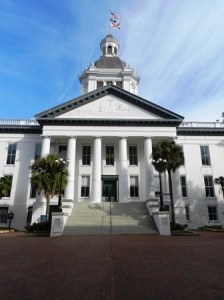 the state now, but it was in the beginning. The Spanish colonies of East Florida and West Florida had capitals in St Augustine and Pensacola; the establishment of Florida territory in 1822 merged the two. The first session of Florida’s Legislative Territorial Council met at Pensacola; members from St Augustine traveled fifty-nine days by water to attend. The next year they met in St Augustine; western delegates traveled around the peninsula on a twenty-eight-day trek. That’s when they agreed on a halfway point, and that was Tallahassee, an abandoned Apalachee settlement. The third session, in 1824, met in a log-cabin; the precedent was set for Tallahassee as capital city. A two-story structure replaced the cabin in 1826; the third capitol was completed by 1845. And the fourth I’m standing in today, despite the “valiant effort” of Senator Wisenborn. » read more
the state now, but it was in the beginning. The Spanish colonies of East Florida and West Florida had capitals in St Augustine and Pensacola; the establishment of Florida territory in 1822 merged the two. The first session of Florida’s Legislative Territorial Council met at Pensacola; members from St Augustine traveled fifty-nine days by water to attend. The next year they met in St Augustine; western delegates traveled around the peninsula on a twenty-eight-day trek. That’s when they agreed on a halfway point, and that was Tallahassee, an abandoned Apalachee settlement. The third session, in 1824, met in a log-cabin; the precedent was set for Tallahassee as capital city. A two-story structure replaced the cabin in 1826; the third capitol was completed by 1845. And the fourth I’m standing in today, despite the “valiant effort” of Senator Wisenborn. » read more
» posted on Thursday, January 3rd, 2013 by Linda Lou Burton
Those Lucky Kids
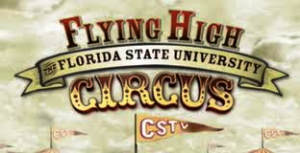 Linda Burton posting from Tallahassee, Florida – Florida State University is famed for football, to be sure. The Seminoles just wrapped up their 2012 season with an Orange Bowl victory over Northern Illinois. But this post focuses on something else FSU is famous for, and that is the Florida State Circus. Ladies and Gentlemen, Boys and Girls, and Children of All Ages, come see the show, come to be entertained, come for the color and the fanfare, come to learn some high-flying skills, because Florida State campus has a Big Top! This exciting program has been around since 1947 and was started when the school went co-ed. It’s not a degree program, it’s an extra-curricular activity under the Student Affairs division and was designed to give male and
Linda Burton posting from Tallahassee, Florida – Florida State University is famed for football, to be sure. The Seminoles just wrapped up their 2012 season with an Orange Bowl victory over Northern Illinois. But this post focuses on something else FSU is famous for, and that is the Florida State Circus. Ladies and Gentlemen, Boys and Girls, and Children of All Ages, come see the show, come to be entertained, come for the color and the fanfare, come to learn some high-flying skills, because Florida State campus has a Big Top! This exciting program has been around since 1947 and was started when the school went co-ed. It’s not a degree program, it’s an extra-curricular activity under the Student Affairs division and was designed to give male and  female students “something to do together.” You must be a degree-seeking student registered at FSU to participate. Unless you’re a lucky kid (between 7-17) in the Summer Program on the Tallahassee campus, or at the resort at Callaway Gardens in Pine Mountain, Georgia. Which takes me back to 1973, when my kids were among those lucky kids. But first, about the Circus program itself. » read more
female students “something to do together.” You must be a degree-seeking student registered at FSU to participate. Unless you’re a lucky kid (between 7-17) in the Summer Program on the Tallahassee campus, or at the resort at Callaway Gardens in Pine Mountain, Georgia. Which takes me back to 1973, when my kids were among those lucky kids. But first, about the Circus program itself. » read more
» posted on Tuesday, January 1st, 2013 by Linda Lou Burton
Happy Birthday!
 Linda Burton posting from Tallahassee, Florida – The first day of the year is a perfect day for reflection. A glance over the shoulder and we can still glimpse the past, even though our feet are firmly pointed towards the new year ahead. But this year Floridians are giving the past much more than a quick glance; you see, it’s Florida’s 500th Birthday and Viva Florida 500 is about to begin. It was 1513 when Juan Ponce de Leon arrived on Florida’s east coast; the first group of Europeans to document such a landing, and to name the place La Florida. Florida’s documented material history dates back more than 12,000 years, but Spain’s claim in 1513 began a new era in human history; it was the foundation that eventually formed the United States of America. The legacy of Spanish Florida started with Ponce de Leon and continued
Linda Burton posting from Tallahassee, Florida – The first day of the year is a perfect day for reflection. A glance over the shoulder and we can still glimpse the past, even though our feet are firmly pointed towards the new year ahead. But this year Floridians are giving the past much more than a quick glance; you see, it’s Florida’s 500th Birthday and Viva Florida 500 is about to begin. It was 1513 when Juan Ponce de Leon arrived on Florida’s east coast; the first group of Europeans to document such a landing, and to name the place La Florida. Florida’s documented material history dates back more than 12,000 years, but Spain’s claim in 1513 began a new era in human history; it was the foundation that eventually formed the United States of America. The legacy of Spanish Florida started with Ponce de Leon and continued 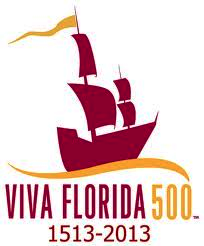 when Pedro Menendez founded St Augustine in 1565, the oldest continuously occupied European settlement in North America. But Spanish explorers were not the only ones; the French established Fort Carolina in 1564; and the British displaced the Spanish in the late 18th century. Under these various flags lived settlers of multiple nationalities; today a number of different cultures thrive in Florida. Viva Florida 500 is about them all, celebrated with a year-long, statewide, big birthday bash. » read more
when Pedro Menendez founded St Augustine in 1565, the oldest continuously occupied European settlement in North America. But Spanish explorers were not the only ones; the French established Fort Carolina in 1564; and the British displaced the Spanish in the late 18th century. Under these various flags lived settlers of multiple nationalities; today a number of different cultures thrive in Florida. Viva Florida 500 is about them all, celebrated with a year-long, statewide, big birthday bash. » read more
